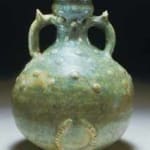Parthian Green-Glazed Terracotta Vase, 100 CE - 300 CE
Terracotta
9.75
X.0128
After the death of Alexander the Great, his expansive empire was divided among three of his most loyal generals, with Seleucis assuming control of the eastern portion. The Seleucid Dynasty...
After the death of Alexander the Great, his expansive empire was divided among three of his most loyal generals, with Seleucis assuming control of the eastern portion. The Seleucid Dynasty was thereby established, following in the footsteps of the Persian, Assyrian, and Babylonian Empires, with its capitals at Antioch (in modern Syria) and Seleucia (in modern Iraq). However, as history has shown, maintaining calm and order over such a large territory, encompassing so many different cultures, proved difficult if not impossible. In 245 B.C., the Parthians revolted against the Seleucids under the leadership of Satrap Andragoras, igniting a civil war that would lead to further autonomy, despite the continued recognition of the Greek kings as their superiors. Although the Parthians had been mentioned in Assyrian text as early as the 7th Century B.C., it was not until the rise of Mithradates I that the yoke of Seleucid control was tossed aside and Parthia reached the heights of its glory. Mithradates the Great quickly conquered the lands of Babylon, Media, and Elam, establishing a great empire that would rival Roman dominance and last until 224 A.D. when the Sassanid Empire finally subjugated their lands.
Parthian ceramics fall into the transitional phase between the ancient and the Islamic period. They combined ancient techniques with new procedures to produce very fine and delicate works. Twin handles with crenulated thumb-rests rise from the shoulder of the vessel to the neck, allowing the vessel to be safely and comfortably transported. The handsome green-glaze still shines with its original luminosity, enhanced by the presence of decorative bosses applied to the neck and shoulders of the work. At the bottom of the spherical body, a mask of ibex with long ridged horns forms a small spout. Most likely, this vase originally contained oil or some other such unguent. Considering the size of the piece, it might have held wine or a similar libation. This stunning vase reminds us of the glories of the Parthian Empire while simultaneously heralding certain aesthetic devices and ceramic techniques that would be further elaborated upon during the Islamic era.
Parthian ceramics fall into the transitional phase between the ancient and the Islamic period. They combined ancient techniques with new procedures to produce very fine and delicate works. Twin handles with crenulated thumb-rests rise from the shoulder of the vessel to the neck, allowing the vessel to be safely and comfortably transported. The handsome green-glaze still shines with its original luminosity, enhanced by the presence of decorative bosses applied to the neck and shoulders of the work. At the bottom of the spherical body, a mask of ibex with long ridged horns forms a small spout. Most likely, this vase originally contained oil or some other such unguent. Considering the size of the piece, it might have held wine or a similar libation. This stunning vase reminds us of the glories of the Parthian Empire while simultaneously heralding certain aesthetic devices and ceramic techniques that would be further elaborated upon during the Islamic era.



